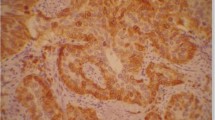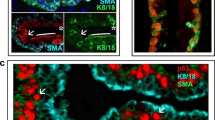Summary
Smears taken from eight probands with carcinoma in situ or invasive carcinoma of the cervix uteri have been stained with DDD and Fast Blue B. The extinctions microspectrometrically measured at 560 nm are directly proportional to the quantity of protein-SH-groups.
The extinctions of the total cell (E ges) and of the cell nucleus (E k) are measured in 67 basal cells (BAS), 78 dysplastic cells (DYS), 122 undifferentiated cancer cells (UNIF) and 89 differentiated cancer cells (POLY). From BAS through DYS and UNIF to POLY E k increases by a total of 176%.
In all four cell types investigated, linear correlations between E k and E ges have been found to occur with a probability of over 99%. The straight lines ascertained represent a relation between E k and E ges which is obviously very characteristic for each cell type, and it becomes apparent that the measuring points corresponding to each single cell are in each instance so close to the straight line that in most cases a differentiation of the three pathological cell types is possible even without a morphological criterion.
The straight lines corresponding to BAS, DYS and UNIF start from a common origin, whereas the straight line corresponding to POLY branches off from the UNIF line only. This is in accordance with the formal genesis of pathological variants observed in the cervical squamous epithelium or in differentiated carcinomas of the squamous epithelium respectively.
Zusammenfassung
Zellabstriche von 8 Patientinnen mit Carcinoma in situ bzw. invasivem Carcinoma der Cervix uteri wurden mit DDD-Echtblau B gefärbt.
Die bei 560 nm mikrospektrometrisch gemessenen Extinktionen sind der Menge an Protein-SH-Gruppen direkt proportional. Die Extinktionen der gesamten Zellen (Eges) und der Zellkerne (E k) wurden an 67 Basai (BAS), 78 dysplastischen (DYS), 122 uniform-atypischen (UNIF) und 89 polymorphatypischen (POLY) Zellen gemessen.
E k nimmt von BAS über DYS und UNIF zu POLY um insgesamt 176% zu. Bei allen 4 untersuchten Zelltypen ergaben sich mit über 99% Wahrschein lichkeit lineare Korrelationen zwischen E k und E ges. Die berechneten Geraden repräsentieren ein für jede Zelltype offenbar sehr charakteristisches Verhältnis von E k zu E ges und es zeigt sich, daß die einzelnen Zellen entsprechenden Meßpunkte jeweils so dicht an den Geraden liegen, daß eine Unterscheidung der 3 pathologischen Zelltypen in den meisten Fällen auch ohne morphologisches Kriterium möglich wird.
Die den BAS, DYS und UNIF entsprechenden Geraden gehen von einem gemeinsamen Ursprung aus, während die den POLY zugehörige Gerade erst von der UNIF-Geraden abzweigt. Dies steht in Übereinstimmung zur formalen Genese pathologischer Varianten des zervikalen Plattenepithels bzw. differenzierter Plattenepithelkarzinome.
Similar content being viewed by others
Literatur
Bajardi,F.: Über Wachstumsbeschränkungen des Collumcarcinoms in seinem invasiven und auch präinvasiven Stadium. Zugleich ein Beitrag zur formalen Genese pathologischen Gebärmutterhalsepithels. Arch. Gynäk. 197, 407–454 (1962)
Bajardi,F.: Spontanregression des pathologischen Gebärmutterhalsepithels im histologischen Bild. Österr. Zschr. Krebsforsch. 27, 1–9 (1972)
Barrnett,J.R., Seligman,A.M.: Histochemical demonstration of protein-bound sulfhydryl groups. Science 116, 323–327 (1952)
Barrnett,J.R., Seligman,A.M.: The histochemical distribution of protein sulfhydryl groups. J. Nat. Cancer Inst. 13, 905–925 (1953)
Barrnett,J.R., Seligman,A.M.: Histochemical demonstration of sulfhydryl and disulfide groups of protein. J. Nat. Cancer Inst. 14, 769–792 (1954)
Burghardt,E.: Histologische Frühdiagnose des Zervixkrebses. Stuttgart: Georg Thieme Verlag, 1972
Esterbauer,H.: Beitrag zum quantitativen histochemischen Nachweis von Sulfhydrylgruppen mit der DDD-Färbung. I. Untersuchung der Farbstoffe. Acta histochem. 42, 351–355 (1972)
Esterbauer,H.: Beitrag zum quantitativen histochemischen Nachweis von Sulfhydrylgruppen mit der DDD-Färbung. II. Bestimmung von SH-Gruppen in unlöslichen Proteinen. Acta histochem. 47, 94–105 (1973)
Esterbauer,H., Nöhammer,G., Schauenstein,E., Weber,P.: Beitrag zum quantitativen histochemischen Nachweis von Sulfhydrylgruppen mit der DDD-Färbung. III. Quantitative cytospektrometrische Bestimmungen an Ehrlich-Ascites-Tumorzellen. Acta histochem. 47, 106–114 (1973)
Fischer-Wasels,B.: Metaplasie und Gewebsmißbildung. In: Bethe's Handbuch der normalen und pathologischen Physiologie, Bd. XIV/2, S. 1211. Berlin: Springer Verlag, 1927
Kern,G.: Carcinoma in situ. Berlin-Göttingen-Heidelberg-New York: Springer Verlag 1964
Nöhammer,G., Schauenstein,E., Bajardi,F., Unger-Ullmann,Cl.: Microphotometrical quantification of protein thiols in morphologically intact cells of cervical epithelium. I. Basic results with superficial cells of healthy women. Acta Cytol. 21, 341–344 (1977)
Author information
Authors and Affiliations
Rights and permissions
About this article
Cite this article
Bajardi, F., Schauenstein, E., Nöhammer, G. et al. Quantifizierung der Proteinthiole in morphologisch normalen Basalzellen und pathologischen Platten-Epithelzellen der Cervix Uteri. Z. Krebsforsch. 91, 291–299 (1978). https://doi.org/10.1007/BF00312291
Received:
Accepted:
Issue Date:
DOI: https://doi.org/10.1007/BF00312291
Key words
- Proteinthiols
- Basal cells
- Dysplastic cells
- Differentiated and undifferentiated cancer cells
- Human cervix uteri epithelium.




